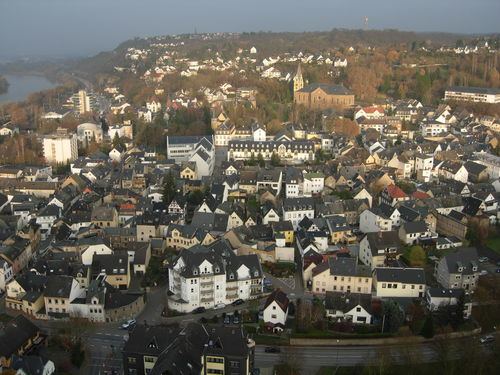Elevation 99 m (325 ft) Population 8,463 (31 Dec 2008) Local time Saturday 12:22 AM | Municipal assoc. Vallendar Time zone CET/CEST (UTC+1/+2) Postal code 56179 | |
 | ||
Weather 13°C, Wind W at 3 km/h, 64% Humidity Colleges and Universities WHU - Otto Beisheim School of Management, College of Philosophy and Theology, Vallendar | ||
Vallendar is a town in the district Mayen-Koblenz, in Rhineland-Palatinate, Germany. It is situated on the right bank of the Rhine, approx. 4 km north-east of Koblenz. Vallendar is the seat of the Verbandsgemeinde ("collective municipality") Vallendar.
Contents
- Map of 56179 Vallendar Germany
- Situation
- Origin of name
- Districts
- History
- Companies
- Traffic
- Education
- Sights
- Persons of interest
- Twin Cities
- Trivia
- References
Map of 56179 Vallendar, Germany
Situation
The town of Vallendar spreads out on the right side of the Mittelrhein opposing the island of Niederwerth, where several creek valleys from the Westerwald meet the Rhine valley. It is situated 5.7 km (3.5 mi) north of Koblenz and 12.3 km (7.6 mi) south of Neuwied. East of Vallendar rises the Westerwald, on the other side of the river the Eifel.
Origin of name
The town's name derives from its situation in the creek valleys. The syllables "val" and have Indo-Germanic roots: "val" means "flowing", whereas "ndar" indicates a "swampy area".
Districts
History
Vallendar is first mentioned around 830–840 AD as the property of the Archbishop of Trier; it was probably, however, of Celtic origin and a lot older (700–600 BC). In 1143 Schoenstatt Abbey was founded. In 1232 the Count of Sayn took possession of the land and began building a castle at the northern edge of the town in 1240. Its foundations today support the Marienburg.
From the 14th century the Archbishop of Trier regained more and more power over the land to become proprietor again in 1681 and in 1767 (for good). Today the Lion of Sayn and the Cross of Trier are evidence of this history in Vallendar's coat of arms. During the Middle Ages a Palatine high court was located in Vallendar. 1802 the proprietorship went to the Count of Nassau-Weilburg; in 1815 it fell to the Kingdom of Prussia. A rich business life is the reason why Frederick William IV of Prussia granted town rights to Vallendar in 1856. In 1939 Mallendar was added to the town. It was the scene of a military action by the 23rd US Infantry. From 1954 to the 1970s numerous new construction areas were established. Since 1973 the skyline has been dominated by the "Humboldthöhe".
Today Vallendar's appearance is influenced mostly by the internationally renowned Schönstatt and the WHU-Otto Beisheim School of Management and its students.
Companies
Traffic
Vallendar is connected to the B 42 and A 48, with the exit Bendorf/Neuwied/Vallendar leading into the city center via B 42.
Vallendar has a train station on the Rheinstrecke.
The KEVAG busses 7/7a and 8/8a connect Vallendar to Koblenz, Bendorf and Höhr-Grenzhausen.
Education
Sights
Persons of interest
Lived in Vallendar:
Twin Cities
Trivia
A city named "Vallendar" is included in the PC game Call of Duty 2. This fictional city also lies on the river Rhine. The players task is to fight retreating German soldiers during World War II. Other than its location on the river the virtual Vallendar has nothing in common with its real world counterpart.
